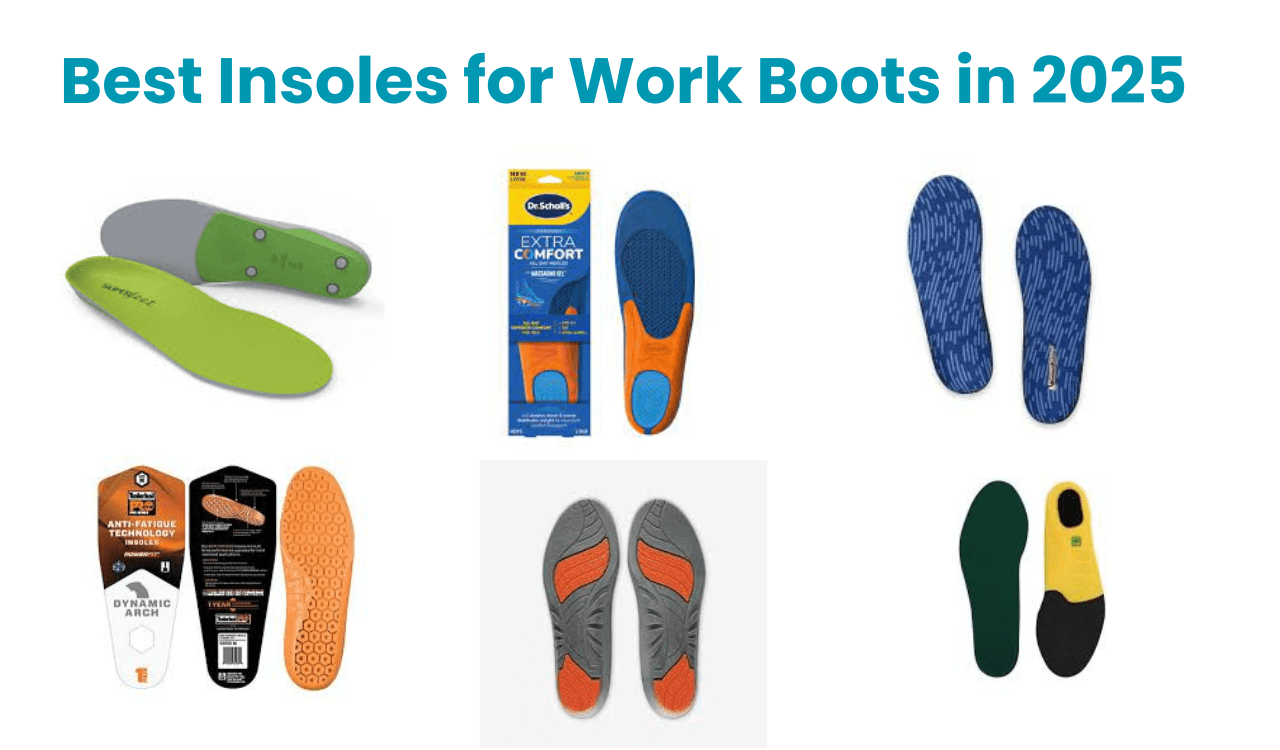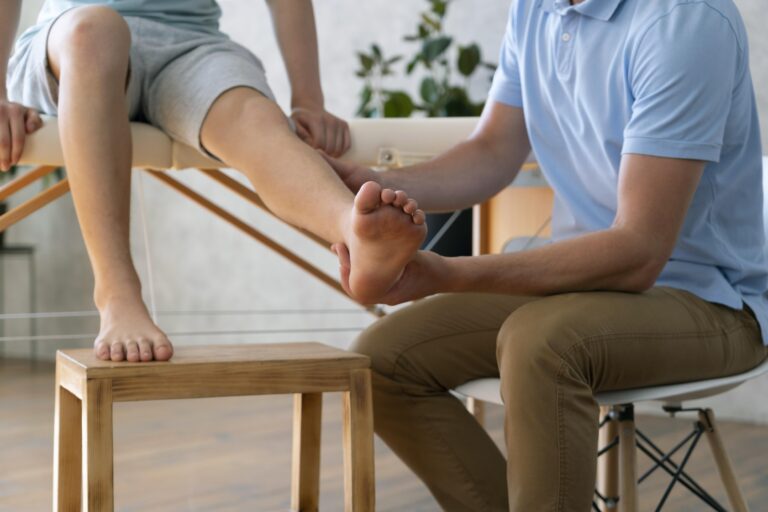Introduction

“Do your work shoes feel like a burden by the end of the day? If sore, tired, or uncomfortable feet are part of your daily routine, you’re not alone.”
For workers who spend long hours on their feet, comfort and support are more than just luxuries—they’re essential for productivity and overall health. Standard work shoes often lack the cushioning and arch support needed for long-term use, which can lead to foot pain, poor posture, and even long-term health problems.
This post will guide you through the top insoles for work shoes in 2025, focusing on options that combine unmatched comfort and durable durability. Whether you’re a construction worker, nurse, or warehouse professional, we’ll help you find the best solution for your needs.
1: Why insoles for work shoes matter?
The Problem with Standard Work Boot Soles
Standard work boots are built tough to withstand tough environments, but their factory insoles often fall short. Common problems include:
- Lack of arch support: Standard soles often don’t accommodate specific arch types, leading to discomfort and strain.
- Insufficient cushioning: Hard, thin insoles fail to absorb shock, leading to long-term foot fatigue.
- Limited durability: Factory insoles wear out quickly, reducing their ability to provide adequate support over time.
Benefits of quality insoles
Investing in high-quality insoles for your work boots can transform your experience:
- Pain relief: Premium insoles reduce common foot pain, including heel pain, arch pain, and ball of the foot pain.
- Better posture and less fatigue: Proper support promotes better alignment, reducing pressure on your legs and lower back.
- Improved durability: Insoles protect the inside of your shoes, extend their lifespan, and offer better long-term value.
Who needs them?
Quality insoles are beneficial for anyone who regularly wears work shoes, especially:
- Construction workers: Standing and moving on hard surfaces all day demands extra cushioning and support.
- Healthcare professionals: Long shifts on their feet make proper support important to avoid fatigue.
- Retail employees: Need cushioning to reduce pain during periods of walking and standing.
- Warehouse and factory workers: Heavy lifting and constant movement increase the need for shock absorption and stability.
Upgrading your insoles can provide the comfort and support you need to thrive in demanding jobs.
2: Key Features to Look for in Insoles
Comfort Factors
When choosing insoles, comfort should be a top priority. Key factors include:
- Cushioning Materials: Insoles made of gel, memory foam, or dual-density foam provide excellent shock absorption and mold to the shape of your foot for superior comfort.
- Ergonomic Design: Contoured designs that support the natural alignment of the foot ensure all-day comfort, reducing fatigue even during long shifts.
Durability Aspects
Work environments require insoles that last as long as your shoes. Look for:
- Durable Materials: Insoles made of durable polyurethane or EVA foam resist cracking and tearing over time.
- Heat and Moisture Resistant Features: Insoles designed to handle sweat and temperature changes maintain their performance in harsh conditions.
Support and Fit
Proper support and fit can make or break an insole’s performance:
Arch support: Choose insoles based on your arch type for optimal support and pressure distribution—whether high, medium, or low.
Custom or trim-to-fit design: Insoles that can be trimmed or molded to fit your shoes, ensuring a comfortable and secure fit.
Additional features
Some insoles offer advanced features for enhanced functionality:
Anti-fatigue technology: Specially designed insoles reduce stress and improve energy return, keeping you moving throughout the day.
Odor control and moisture wicking features: Odor-resistant and moisture-wicking features keep your shoes fresh and dry, even on the toughest work days.
By focusing on these key features, you can find insoles that enhance your comfort, support, and stability — helping you get the most out of your work shoes.
3: Top Picks for the Best Insoles for Work Boots in 2025
SuperFeet Green Professional Grade Insoles
Affiliate Link : Superfeet Insoles
Key Features:
- High-density foam for maximum cushioning.
- Deep heel cup for improved stability.
- Durable construction for long-lasting use.
Pros:
- Excellent arch support for high arches.
- Ideal for extended wear and heavy-duty jobs.
Cons:
- Slightly higher price point.
- Can feel stiff during breaks.
Best for: Workers with high arches or those in physically demanding roles, such as construction or landscaping.
Dr. Scholl’s Work Massaging Gel Advanced Insoles
Affiliate Link : Dr. Scholl’s Advanced Insoles
Key Features:
- Dual-layer gel technology for shock absorption.
- Flexible design for a variety of foot shapes.
- Cooling vents to reduce heat buildup.
Pros:
- Affordable and widely available.
- Comfortable for medium to low arch types.
Cons:
- May wear out quickly with heavy use.
- Limited arch support for high arches.
Best for: Retail workers, healthcare professionals, or anyone who is on their feet all day.
Timberland PRO Anti-Fatigue Technology Insoles
Affiliate Link : Timberland PRO Tech Insoles
Key Features:
- Special anti-fatigue design for energy return.
- Contoured shape for high arch support.
- Moisture-wicking and odor-control features.
Pros:
- Outstanding comfort for long-term wear.
- Durable and resistant to wear and tear.
Cons:
- Bulkier design may not fit all boot types.
- Higher price than typical insoles.
Best for: Warehouse workers, factory workers, and those who do physically demanding jobs.
More Recommendations
PowerStep Pinnacle Maxx: Provides better arch support and reduces foot pain for those with plantar fasciitis.
Sof Sole Athlete Performance Insoles: Ideal for workers who need a balance of cushioning and flexibility.
Spanco Polysorb Heavy Duty Insoles: Perfect for those looking for maximum shock absorption for demanding work environments.
These insoles represent the best of 2025, offering solutions tailored to a variety of needs and industries.
4: Comparison Chart
Here’s a quick comparison of the top insoles for work boots in 2025, highlighting their key features:
| Insole Name | Comfort Level | Durability | Support Type | Price Range | Target Users |
| SuperFeet Green | High | Excellent | High arch, deep heel cup | $49.95 – $54.99 | Heavy-duty workers, high-arch individuals |
| Dr. Scholl’s Work Gel | Moderate to High | Moderate | Medium to low arch | Approximately $29.99 | Retail workers, healthcare professionals, everyday users |
| Timberland PRO Anti-Fatigue | High | Excellent | Contoured, medium support | Around $35.00 | Warehouse staff, factory workers, physically intensive roles |
| PowerStep Pinnacle Maxx | High | High | Maximum arch support | $44.96 – $49.95 | Those with plantar fasciitis or foot pain |
| Sof Sole Athlete | Moderate | Moderate to High | Balanced cushioning | $20.00 – $31.00 | General-purpose workers needing flexibility |
| Spenco Polysorb Heavy Duty | High | High | Heavy cushioning, moderate arch | Approximately $24.99. | Workers needing shock absorption and durability |
Key Notes:
- Comfort Level: Indicates how well the insole adapts to prolonged use.
- Durability: Reflects resistance to wear and tear under demanding conditions.
- Support Type: Highlights the specific arch and foot support each insole offers.
- Price Range:
- $: Budget-friendly (< $30)
- $$: Mid-range ($30–$50)
- $$$: Premium (> $50)
- Target Users: Suggested for specific industries or foot conditions.
This chart simplifies decision-making, allowing you to choose the best insole based on your needs and preferences.
5: How to choose the right insoles for your work shoes
Choosing the perfect insoles for your work shoes involves balancing your personal preferences, work needs, and budget. Here’s how to make an informed decision:
Assess your needs
- Comfort: If you experience fatigue or discomfort while standing or walking for long hours, consider cushioning.
- Support: Look for insoles with specific arch support (low, medium, or high) to reduce foot pain and improve posture.
- Durability: For rough work environments, choose insoles made from long-lasting materials like gel or high-density foam.
Consider your work environment.
- High-impact jobs: If you work in construction or heavy-duty industries, choose insoles with shock absorption and firm support.
- Low-impact jobs: For retail or desk jobs, lightweight and flexible insoles may be enough for all-day comfort.
Check the fit and feel.
- Try them on: Always test the insoles inside your work shoes to make sure they’re a good fit. Trim-to-fit designs are ideal for a customized experience.
- Assess performance: Walk around and see if the insoles provide comfort and support. Look for signs of reduced pain or improved posture.
Budget considerations
Basic needs: Inexpensive insoles ($30 or less) can provide adequate comfort for light use.
Invest in quality: Premium insoles ($30–$50+) offer features like improved durability, superior support, and anti-fatigue technology.
Cost vs. longevity: Spending a little more on durable insoles can save you money over time by reducing the need for frequent replacements.
By focusing on these factors, you can choose insoles that perfectly match your work demands, ensuring both comfort and productivity during your workday.
6: Care Tips for Work Boot Insoles
Proper care for your insoles can significantly extend their lifespan and keep them performing at their best. Follow these tips to ensure durability and hygiene:
Cleaning and Maintenance
Clean regularly: Remove the insoles from your shoes and clean them every 1-2 weeks. Use a mild soap solution and a soft brush to remove dirt and sweat buildup.
Dry thoroughly: Allow the insoles to air dry completely before putting them back in your shoes. Avoid direct sunlight or heat sources, as they can cause warping.
Control odor: Sprinkle baking soda or use an odor-neutralizing spray to keep the insoles fresh and free of unpleasant odors.
Signs of Replacement
Flattened Cushioning: If the insoles don’t provide adequate support or feel squashed, it’s time to replace them.
Visible damage: Cracks, tears, or broken parts are clear signs that the insoles need to be replaced.
Increased discomfort: Persistent pain or fatigue in your feet despite wearing the insoles indicates that they have lost their effectiveness.
Storage tips
Proper storage: Remove the insoles from the boots during storage to allow ventilation and prevent moisture buildup.
Avoid folding: Store the insoles flat to maintain their shape and structural integrity.
Protective storage: Store the insoles in a cool, dry place away from direct sunlight to prevent damage from heat or moisture.
By following these care tips, you can maximize the life of your insoles and ensure that they continue to provide the comfort and support you need throughout your workday.
7: Frequently Asked Questions
- What are the best insoles for people with flat feet?
Insoles designed for flat feet should offer firm arch support and cushioning to relieve discomfort. Look for insoles labeled “orthotic” or “designed for flat feet,” such as those made of high-density foam or gel that conforms to the shape of your foot.
- Can insoles help prevent blisters in work boots?
Yes, insoles with moisture-wicking properties and a snug fit can reduce friction and keep your feet dry, helping to prevent blisters. Choose insoles with a smooth surface and supportive padding to minimize friction.
- How often should I replace work boot insoles?
The lifespan of insoles depends on usage and quality, but a general guideline is:
Replace every 6-12 months with regular daily use.
If you notice signs of wear, loss of cushioning, or discomfort, it’s time for a replacement, even if it’s sooner than expected.
- Are custom orthotics better than generic insoles?
Custom orthotics are made specifically for the unique needs of your foot and are ideal for addressing medical conditions like plantar fasciitis or severe arch issues. However, generic insoles are often sufficient for general comfort, affordability, and moderate support. Opt for custom orthotics if you need special care and can afford the higher price tag.
These FAQs address common concerns and guide readers toward making informed decisions about their work boot insoles.
Conclusion
Using quality insoles for work shoes can significantly improve your everyday comfort, reduce fatigue, and support the overall health of your feet. They reduce pain, improve posture, and even extend the life of your shoes by providing better shock absorption and fit.
Investing in high-quality insoles is a smart choice for anyone who spends long hours on their feet. Whether you’re tackling a construction site, working in retail, or managing a physically demanding job, the right insoles can make all the difference in your comfort and productivity.
Ready to upgrade your work shoes with the best insoles of 2025? Explore our top picks and find the perfect fit for your needs. Don’t forget to share your experiences or ask any questions in the comments below — we’d love to hear from you!
“Disclaimer: This post contains affiliate links. If you make a purchase through these links, I may earn a small commission at no extra cost to you. Thank you for supporting my blog!”


